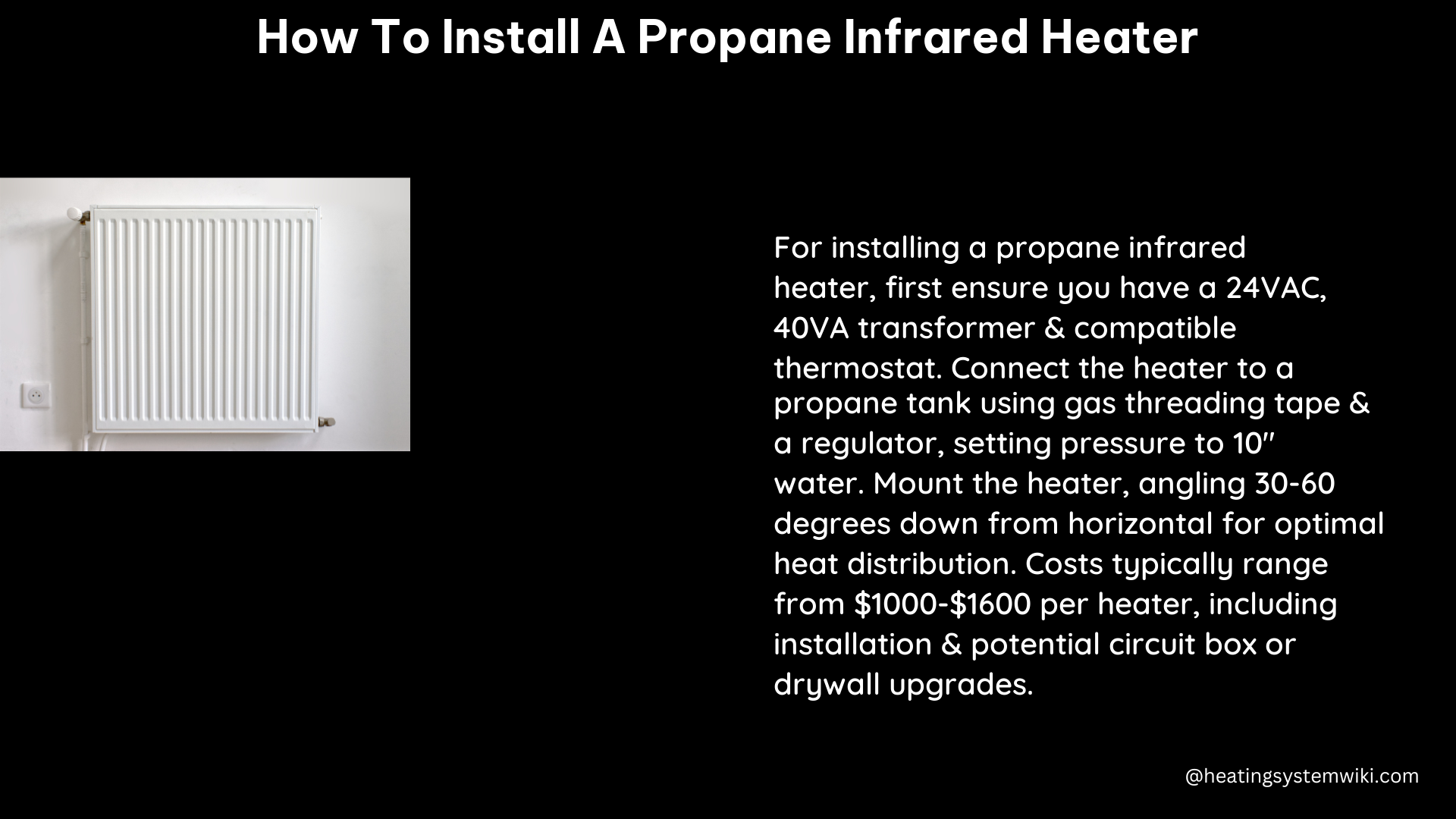Installing a propane infrared heater can be a cost-effective and efficient way to heat your indoor or outdoor space. These heaters use infrared technology to directly warm objects and people, rather than heating the air, making them a highly efficient heating solution. In this comprehensive guide, we’ll walk you through the step-by-step process of installing a propane infrared heater, covering everything from site preparation to testing for proper operation.
Preparing the Installation Site
Before you begin the installation process, it’s crucial to choose the right location for your propane infrared heater. The installation site should be well-ventilated, away from any flammable materials, and easily accessible for maintenance and repair. Once you’ve selected the perfect spot, you’ll need to prepare the area by cleaning it and ensuring it’s level.
When choosing the installation site, consider the following factors:
- Proximity to a propane tank or gas line
- Clearance from walls, ceilings, and other obstructions (typically at least 36 inches)
- Accessibility for maintenance and servicing
- Proximity to electrical outlets for the thermostat and transformer
- Adequate ventilation to prevent the buildup of combustible gases
Connecting the Gas Components

The first step in connecting the gas components is to attach the propane tank to the heater using a dual-tank connection kit. This process can be a bit tricky, as many of the threads going into the tanks will screw in counterclockwise instead of clockwise. To disconnect the lines from the tanks, unscrew them in reverse.
Here’s a step-by-step guide to connecting the gas components:
- Connect one line to the second propane tank by screwing it in counterclockwise.
- Attach the other end of the line to the brass tee.
- In the middle of the tee, you’ll find the tank connection, which you’ll need to thread into the tank counterclockwise.
- Screw the regulator into the opposite end of the tee.
- Run the remaining line through the wall to the heater.
Be sure to use orange thread tape or sealant at all connections to prevent any leaks. Propane is highly explosive, so it’s crucial to ensure a tight, secure connection.
Next, connect the ⅜-inch elbow to the LP gas inlet on the bottom corner of the heater using gas threading tape. Attach 1½ inches of ⅜-inch black iron pipe, and then use a brass nipple to connect from the reducer on the right by threading it in.
Connecting the Electrical Components
The electrical components of a propane infrared heater include a thermostat and a transformer. The thermostat should be connected to the heater using thermostat wire, while the transformer should be connected using a 24VAC, 40VA transformer.
The transformer can be mounted either on the cover of a 4×4 square metal junction box or in a 1/2″ trade size knockout on the side of such a box. Both of these wiring methods put the mains power inside the metal junction box and the 24VAC power on the outside.
When connecting the electrical components, be sure to follow all local electrical codes and safety guidelines. It’s also a good idea to consult with a licensed electrician if you’re not comfortable with the electrical work.
Testing for Leaks and Proper Operation
Once you’ve made all the necessary connections, it’s time to test for leaks and ensure the heater is operating correctly. Start by turning on the gas at the tanks by opening the valves. Then, use a soapy water solution to check for leaks at all the connections. If you see any bubbles forming, tighten the connections or replace any faulty components.
After testing for leaks, turn on the heater and check for proper operation. The heater should ignite and produce heat. If the heater doesn’t ignite or produce heat, double-check the gas and electrical connections and ensure the thermostat is set correctly.
Technical Specifications
The technical specifications of a typical propane infrared heater include:
| Specification | Value |
|---|---|
| Power Output | 30,000 BTUs |
| Gas Type | Propane |
| Electrical Requirements | 24VAC, 40VA transformer |
| Connection Type | Dual-tank connection kit |
| Gas Inlet Size | ⅜-inch |
| Pipe Material | Black iron |
| Regulator Pressure Setting | 10 inches of water |
| Inlet Gas Pressure (Maximum) | 14 inches of water |
DIY Approach
Installing a propane infrared heater can be a DIY project, but it’s essential to follow all safety precautions and instructions carefully. If you’re not confident in your abilities or don’t have the necessary skills and tools, it’s recommended to hire a professional to install the heater.
When tackling a DIY installation, make sure you have the following tools and materials on hand:
- Dual-tank connection kit
- ⅜-inch black iron pipe and fittings
- Thermostat wire
- 24VAC, 40VA transformer
- Soapy water solution for leak testing
- Wrench, pliers, and other basic hand tools
Remember, safety should be your top priority when working with propane and electrical components. If you’re unsure about any part of the installation process, it’s better to err on the side of caution and seek professional assistance.
References:
– How do I install a high-intensity infrared heater and thermostat?
– Installing a Propane Heater
– Propane Heater Installation
– Propane Heater Installation and Setup
– Propane Heater Installation Tips
